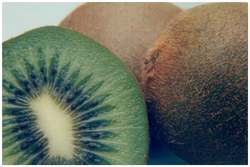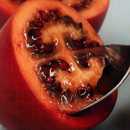Kiwifruit |
| |
||
 |
||
 |
||
 |
||
Originally native to eastern Asia. The Chinese have collected the fruit from the wild for thousands of years but it is thank you to New Zealand for domesticating this plant and making it a very important crop to New Zealand.
Landscape Value
Looks lovely growing over a pergola, or along a substantial fence or trellis. These must be strong structures as the vines with fruit are very heavy.
Nutritional Value
Higher concentration of vitamins and minerals than most other fruit. Very high in antioxidants and one of the best sources of vitamin C, good levels of potassium, vitamin E and vitamin A. High in antioxidants and fibre.
How to Eat
Still firm and just under ripe. Eaten fresh on their own or added to desserts and savoury dishes as a garnish. Rarely cooked. Made into juice, wine, jam and sliced and dried. Best with meats as its high quantities of a proteolytic enzyme called actinidin is effective in tenderizing meat.
Expected Yield
Vines usually begin cropping at 4 years, reaching full potential at 9-10 years, but can continue producing for another 40 + years. A mature vine can produce 150-200 fruit per year. A maximum from a plant can be 80Kg but most vines are more likely to produce 20Kg.
Generic Fruiting Time
| J | F | M | A | M | J | J | A | S | O | N | D |
Growing
Sun
Full sun or semi-shade.
Wind
Protect from wind, strong winds will break their stems, leaves and fruits.
Salt
Not salt tolerant.
Climate
Prefers a warm temperate to sub-tropical climate, is fairly frost tolerant but late frosts can damage or kill young buds.
Soil
Grows best in deep, fertile, friable loam. Wide PH range 5.5
Fertiliser
General NPK fertilizer or manure compost with a lower nitrogen level to encourage fruiting.
Pruning
In winter remove year old wood and again in summer by tipping the growth to keep it within bounds. Needs to be more severe on Hayward (female). Vines are best pruned and trained so that the flowers and fruit hang outside the leaves, results in much better flowering, fruit quality and yields. Remove some leaves in late summer so sunlight can increase bud formation. Pruning in winter and summer controls vegetative growth and suppress shoot growth. Winter pruning removes older wood, whereas summer pruning removes stems that are too vigorous. Flowers are formed on the new season's growth arising from leaf axils of last season's growth ... read more about pruning
Pests
May suffer from various problems if soil is too wet. Possible Fungal and bacteria diseases include crown gall, Botrytis and Phytophthora root rot also Armillarea mellea can kill vines. Other possible problems include scale, leaf roller caterpillars, passion-vine hopper, thrips, least spot, scale insects and root-knot nematodes.
Hardiness
-10°C
Special Conditions
Vines need 400-700hrs below 7


